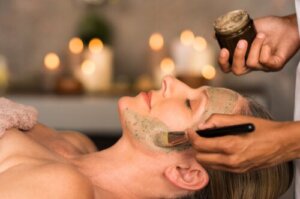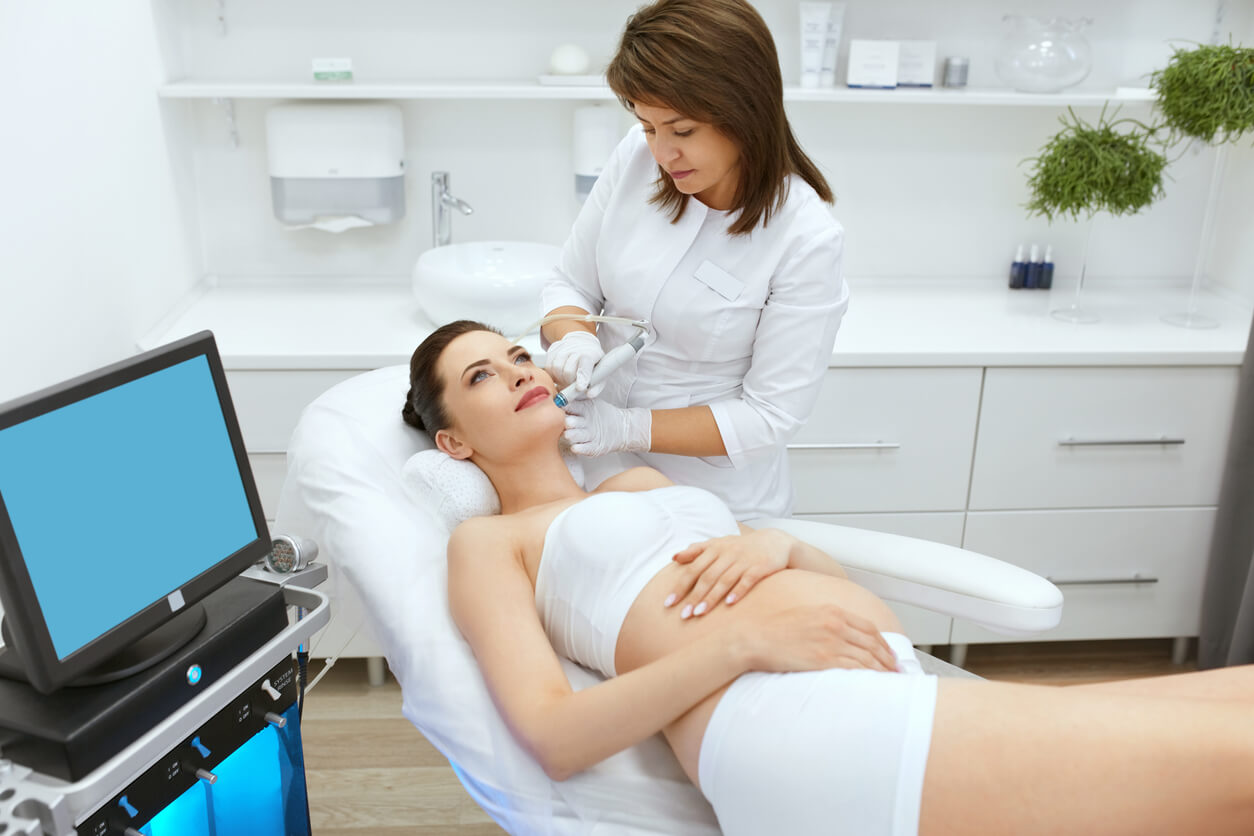Skin Exfoliation During Pregnancy: Everything You Need to Know

Skin exfoliation during pregnancy is a great option for maintaining a proper skincare routine. While there are multiple methods, not all of them are appropriate for pregnant women. In this article, we’ll tell you all about it. Are you interested? Keep reading!
What is exfoliation and what does it do?
Exfoliation is a technique that helps to detach and eliminate, in a controlled manner, the most superficial cells of the skin, with or without part of the dermis. This favors the remodeling and regeneration of the skin surface, in addition to facilitating the removal of all the impurities located there.
Exfoliants also help to accelerate the skin renewal process. From the removal of old cells, a new layer of skin rises to the surface to grow, develop, and improve tissue oxygenation.
Skin exfoliation is quite useful and effective in the following conditions:
- Melasma
- Acne scars
- Photoaging
- Aging skin
Also, it helps the epidermis texture to become smoother, softer, and more homogeneous, to recover its brightness and vitality.

Mechanical exfoliation
Mechanical exfoliation is a manual or physical procedure that involves vegetable sponges, soft granulated creams, certain gloves, mechanical facial brushes, or microblading. Therefore, these procedures do not involve acid solutions that peel off the superficial layer of the epidermis.
Consequently, mechanical peeling is gentler and more superficial than chemical peeling. Creams or gels containing tiny particles capable of dragging impurities from the skin are ideal for this procedure. Likewise, it’s always important to consult a doctor if you have any questions or doubts.
Chemical exfoliation
There are different types of acids and solutions that are used to dissolve dead cells from the surface of the skin:
- Alpha hydroxy acid (AHA)
- Beta hydroxy acids (BHA)
- Phenol
- Trichloroacetic acid (TCA)
According to a review in the International Journal of women’s Dermatology, the use of lactic and glycolic acid is considered safe during pregnancy. Even glycolic acid peels in concentrations of 30 to 70 % have insignificant penetration of the dermis, so they can be used without problems. However, trichloroacetic acid should be avoided or applied with extreme caution at this stage.
A good treatment option for gestational acne, which does not cause fetal risks, is 2% lactic acid.
Read also: Dermatological Treatments During Pregnancy: What You Should Know
Indications for skin exfoliation during pregnancy
Whatever type of exfoliating agent or mechanism is used, the specific indications for its use must be respected. These include the following:
- Pigmentary disorders, including lentigines, post-inflammatory hyperpigmentation macules, melasma, and freckles, or ephelides.
- The proliferation of the epidermis and precancerous lesions, including sebaceous and actinic keratoses.
- Rejuvenation of facial skin to treat aesthetic conditions, such as enlarged pores or wrinkles.
- Inflammatory processes, including rosacea, acne vulgaris, post-acne scarring, and pseudofolliculitis of the chin.
This procedure should be implemented in the skincare routine every 20 days. In turn, sunscreen should always be applied and renewed every two hours to prevent the development of hyperpigmented spots on the skin.
The safety of skin peels and pregnancy
It’s quite complex to determine the safety of peels in pregnant women, as several questions arise.
In general, pregnant women are advised to avoid the use and application of certain topical agents with unclear safety data, such as hydroquinone and tazarotene. It’s even recommended that they avoid active ingredients such as salicylic acid and retinol, as they could cause birth defects in the baby.
For all these reasons, dermatologists don’t recommend starting procedures or treatments to combat the physiological alterations of pregnancy during this stage. In fact, they can recover better after childbirth, as is the case with melasma.

You may be interested in: A Pregnancy Beauty Guide to Keep You Looking Good!
Post-peel care
One of the immediate care steps after skin exfoliation is the application of a moisturizing emulsion to nourish the new cell layers of the epidermis. In addition, during pregnancy, there’s a greater predisposition to developing hyperpigmented spots, so it’s important to reinforce the care of this delicate tissue.
The susceptibility of the skin is caused by the hormonal alterations of pregnancy that stimulate the production of melanin. Therefore, the most important indication for skin care is the constant and daily use of sunscreen.
Final considerations of exfoliation and pregnancy
Pregnant skin tends to change in appearance and texture and to prevent damage, moisturizing, and exfoliation are fundamental steps in the care routine. Therefore, in case of opting for a chemical peel, it would be best to go to the doctor and avoid home treatments, as they could be inappropriate and unsafe.
Skin exfoliation during pregnancy is a great option for maintaining a proper skincare routine. While there are multiple methods, not all of them are appropriate for pregnant women. In this article, we’ll tell you all about it. Are you interested? Keep reading!
What is exfoliation and what does it do?
Exfoliation is a technique that helps to detach and eliminate, in a controlled manner, the most superficial cells of the skin, with or without part of the dermis. This favors the remodeling and regeneration of the skin surface, in addition to facilitating the removal of all the impurities located there.
Exfoliants also help to accelerate the skin renewal process. From the removal of old cells, a new layer of skin rises to the surface to grow, develop, and improve tissue oxygenation.
Skin exfoliation is quite useful and effective in the following conditions:
- Melasma
- Acne scars
- Photoaging
- Aging skin
Also, it helps the epidermis texture to become smoother, softer, and more homogeneous, to recover its brightness and vitality.

Mechanical exfoliation
Mechanical exfoliation is a manual or physical procedure that involves vegetable sponges, soft granulated creams, certain gloves, mechanical facial brushes, or microblading. Therefore, these procedures do not involve acid solutions that peel off the superficial layer of the epidermis.
Consequently, mechanical peeling is gentler and more superficial than chemical peeling. Creams or gels containing tiny particles capable of dragging impurities from the skin are ideal for this procedure. Likewise, it’s always important to consult a doctor if you have any questions or doubts.
Chemical exfoliation
There are different types of acids and solutions that are used to dissolve dead cells from the surface of the skin:
- Alpha hydroxy acid (AHA)
- Beta hydroxy acids (BHA)
- Phenol
- Trichloroacetic acid (TCA)
According to a review in the International Journal of women’s Dermatology, the use of lactic and glycolic acid is considered safe during pregnancy. Even glycolic acid peels in concentrations of 30 to 70 % have insignificant penetration of the dermis, so they can be used without problems. However, trichloroacetic acid should be avoided or applied with extreme caution at this stage.
A good treatment option for gestational acne, which does not cause fetal risks, is 2% lactic acid.
Read also: Dermatological Treatments During Pregnancy: What You Should Know
Indications for skin exfoliation during pregnancy
Whatever type of exfoliating agent or mechanism is used, the specific indications for its use must be respected. These include the following:
- Pigmentary disorders, including lentigines, post-inflammatory hyperpigmentation macules, melasma, and freckles, or ephelides.
- The proliferation of the epidermis and precancerous lesions, including sebaceous and actinic keratoses.
- Rejuvenation of facial skin to treat aesthetic conditions, such as enlarged pores or wrinkles.
- Inflammatory processes, including rosacea, acne vulgaris, post-acne scarring, and pseudofolliculitis of the chin.
This procedure should be implemented in the skincare routine every 20 days. In turn, sunscreen should always be applied and renewed every two hours to prevent the development of hyperpigmented spots on the skin.
The safety of skin peels and pregnancy
It’s quite complex to determine the safety of peels in pregnant women, as several questions arise.
In general, pregnant women are advised to avoid the use and application of certain topical agents with unclear safety data, such as hydroquinone and tazarotene. It’s even recommended that they avoid active ingredients such as salicylic acid and retinol, as they could cause birth defects in the baby.
For all these reasons, dermatologists don’t recommend starting procedures or treatments to combat the physiological alterations of pregnancy during this stage. In fact, they can recover better after childbirth, as is the case with melasma.

You may be interested in: A Pregnancy Beauty Guide to Keep You Looking Good!
Post-peel care
One of the immediate care steps after skin exfoliation is the application of a moisturizing emulsion to nourish the new cell layers of the epidermis. In addition, during pregnancy, there’s a greater predisposition to developing hyperpigmented spots, so it’s important to reinforce the care of this delicate tissue.
The susceptibility of the skin is caused by the hormonal alterations of pregnancy that stimulate the production of melanin. Therefore, the most important indication for skin care is the constant and daily use of sunscreen.
Final considerations of exfoliation and pregnancy
Pregnant skin tends to change in appearance and texture and to prevent damage, moisturizing, and exfoliation are fundamental steps in the care routine. Therefore, in case of opting for a chemical peel, it would be best to go to the doctor and avoid home treatments, as they could be inappropriate and unsafe.
All cited sources were thoroughly reviewed by our team to ensure their quality, reliability, currency, and validity. The bibliography of this article was considered reliable and of academic or scientific accuracy.
- Bozzo P, Chua-Gocheco A, Einarson A. Safety of skin care products during pregnancy. Can Fam Physician. 2011 Jun;57(6):665-7. PMID: 21673209; PMCID: PMC3114665.
- Trivedi MK, Kroumpouzos G, Murase JE. A review of the safety of cosmetic procedures during pregnancy and lactation. Int J Womens Dermatol. 2017 Feb 27;3(1):6-10. doi: 10.1016/j.ijwd.2017.01.005. PMID: 28492048; PMCID: PMC5418954.
- Basit H, Godse KV, Al Aboud AM. Melasma. 2021 Nov 5. In: StatPearls [Internet]. Treasure Island (FL): StatPearls Publishing; 2022 Jan–. PMID: 29083744.
This text is provided for informational purposes only and does not replace consultation with a professional. If in doubt, consult your specialist.








